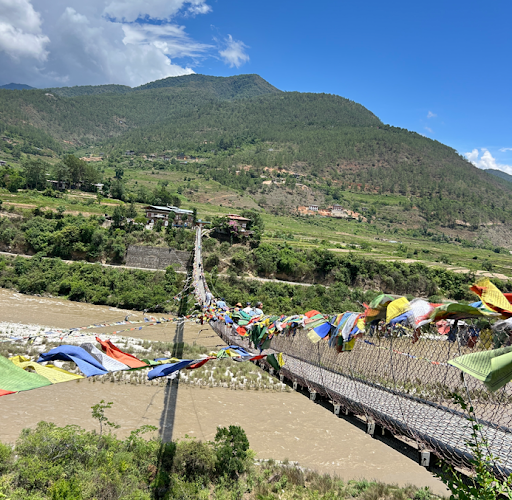Have you ever felt the urge to leave behind Bengaluru’s traffic and endless workdays, and instead find yourself surrounded by mountains, monasteries, and a culture that celebrates happiness? Bhutan gives you exactly that. Just a short flight away, this tiny Himalayan kingdom offers the calm of nature, the depth of spirituality, and the warmth of a culture that feels both ancient and welcoming.
If you’ve got 5 days in hand, this Bengaluru to Bhutan itinerary is the perfect way to blend culture, nature, and a bit of adventure.
How to Reach Bhutan from Bengaluru
First things first—there are no direct flights from Bengaluru to Bhutan. But the journey is simple enough with a connection.
- By Air (Most Popular):
You can take a flight from Bengaluru to Kolkata or Delhi, and from there, connect to Paro International Airport. The landing at Paro is considered one of the most scenic in the world—you’ll see valleys and Himalayan peaks right outside your window. - By Land (Scenic Alternative):
You can fly from Bengaluru to Bagdogra (West Bengal), then take a 4–5 hour drive to Jaigaon on the Indian side. From here, you can cross into Phuentsholing, Bhutan. This route is ideal if you want to combine your Bhutan trip with Darjeeling or Sikkim.
Tip: For a short 5-day Bhutan trip, flying directly into Paro saves time. Take the land route only if you’re extending your journey to North Bengal or Sikkim.

5-Day Bhutan Itinerary from Bengaluru
Day 1: Arrive in Paro – First Taste of Bhutan
Once you land at Paro, you’ll immediately feel the difference—fresh mountain air, colourful prayer flags, and quiet valleys. Start with:
- National Museum (Ta Dzong): Once a watchtower, now showcasing Bhutan’s heritage with thangkas, textiles, and old weapons.
- Paro Dzong (Rinpung Dzong): A fortress-monastery where monks chant in crimson robes while administrative work continues quietly.
Evening tip: Take a walk through Paro town. Try momos or a bowl of thukpa at a local eatery, browse handicraft shops, and soak in the slower pace of life. Stay in a guesthouse or small boutique hotel for your first Bhutanese night.
Day 2: Hike to Tiger’s Nest Monastery (Taktsang)
This is Bhutan’s crown jewel and a must for every traveller.
- The Hike: About 2–3 hours uphill (4–5 hours round trip), starting early at 8 AM. The trail winds through pine forests with prayer flags fluttering in the wind. Horses are available for part of the climb if you need support.
- The Experience: Legend says Guru Padmasambhava flew here on a tigress to meditate. Inside, flickering butter lamps and chanting monks create a spiritual atmosphere that feels worlds away from city life.
After the trek, treat yourself to a traditional hot stone bath—a wooden tub heated with fire-warmed river stones. If you’re curious, you can also try archery, Bhutan’s national sport, or join a cooking session to learn how ema datshi (chilli cheese curry) is made.
Day 3: Paro to Thimphu – Bhutan’s Capital with a Twist
The drive from Paro to Thimphu takes just 1.5 hours, but the scenery will make you want to pause. Thimphu feels modern yet deeply traditional—here’s where you’ll see monks in monasteries and young Bhutanese sipping coffee in trendy cafés.
- Memorial Chorten: A stupa where locals gather every day for prayers, spinning prayer wheels in devotion.
- Buddha Dordenma: A massive golden statue overlooking the valley, filled with thousands of smaller Buddhas inside.
- Folk Heritage Museum: Step into a 19th-century farmhouse and see how Bhutanese families once lived—mud walls, wooden tools, and open-hearth kitchens.
- Centenary Farmers Market: Meet farmers selling red rice, dried chillies, and yak cheese. A great place to taste Bhutanese flavours and interact with locals.
Evening idea: Attend a cultural show with folk dances and songs, where your guide can explain the stories behind the masks and movements.

Day 4: Thimphu to Punakha – Through Dochula Pass
This drive is easily one of the most beautiful in Bhutan.
- Dochula Pass: Stop here for tea with views of the eastern Himalayas, framed by 108 white chortens. On clear mornings, the panorama is breathtaking.
Once in Punakha:
- Punakha Dzong: Often called the “Palace of Great Happiness,” this fortress is stunning in spring when purple jacaranda trees bloom. It’s also where Bhutanese kings were coronated.
- Suspension Bridge: One of the longest in Bhutan, strung with prayer flags over the Pho Chhu and Mo Chhu rivers. Crossing it is both thrilling and serene.
- Chimi Lhakhang (Fertility Temple): Dedicated to Lama Drukpa Kunley, the “Divine Madman.” Couples come here to seek blessings for children.
For a more immersive experience, choose a farmhouse stay—sharing meals like red rice, butter tea, and home-style curries with a local family is a memory you’ll carry long after your trip.
Day 5: Back to Paro – A Gentle Goodbye
Return to Paro for your flight back to Bengaluru. Before you leave:
- Kyichu Lhakhang: One of Bhutan’s oldest temples, where monks and villagers spin prayer wheels in quiet devotion.
- Handicraft Shopping: Pick up handwoven scarves, thangka paintings, or wooden crafts as souvenirs.
- Final Meal: Don’t miss Bhutan’s fiery but comforting dishes—momos, thukpa, and of course ema datshi.
As your plane takes off, you’ll see the valleys and dzongs fading into the clouds. Five days may feel short, but Bhutan leaves you with a sense of peace that lingers long after you’re home.
Essential Travel Tips for Bhutan
- Entry Rules for Indians:
- Sustainable Development Fee (SDF): INR 1,200/- per person, per night.
- Licensed Bhutanese guides and local taxis are mandatory.
- Special permits are needed for regions beyond Paro and Thimphu (like Punakha).
- Best Time to Visit Bhutan:
- Spring (Mar–May): Blooming valleys and pleasant weather.
- Autumn (Sep–Nov): Clear skies and vibrant festivals.
- Winter (Dec–Feb): Quiet, fewer tourists, and snowy mountains.
- Packing & Culture:
- Carry warm clothes, even in summer—mountain weather shifts quickly.
- Dress modestly when visiting monasteries (covered shoulders and legs).
- Try local food—red rice, butter tea, and dried chilli dishes are staples.
Why This Trip Stays With You
A trip from Bengaluru to Bhutan is not about rushing through landmarks—it’s about slowing down. It’s about hearing monks chant at dawn, sipping butter tea with a local family, or standing on a suspension bridge as prayer flags flutter in the wind.
Five days here won’t just give you a holiday. They’ll give you perspective—a reminder that sometimes, happiness is found in simplicity.
FAQs
How many days are enough for Bhutan?
For a quick trip, 5–6 days covering Paro, Thimphu, and Punakha is ideal. If you have more time, consider adding Phobjikha or Bumthang for a deeper cultural experience.
What is the cost of a 5-day Bhutan trip from Bengaluru?
Besides flights, factor in INR 1,200/- per person/night for the SDF, accommodation (budget guesthouses to luxury hotels), meals, and guide fees. On average, a mid-range 5-day trip may cost INR 45,000/- – 60,000/- per person.
Is the Tiger’s Nest trek difficult?
It’s moderately challenging but doable for anyone with average fitness. Horses are available for part of the way, but walking gives you the full experience.
Can Indians travel to Bhutan without a guide?
No, as per the new rules, Indian travellers must hire a licensed Bhutanese guide and use local taxis.
Do Indians need a visa or special documents to enter Bhutan?
Indian citizens do not require a visa to enter Bhutan, but must carry either a valid passport with at least 6 months’ validity or a Voter ID card to obtain an entry permit on arrival.
Is vegetarian or non-vegetarian food easily available in Bhutan?
Vegetarian food is widely available throughout Bhutan, and the country is also known for its flavorful non-vegetarian dishes such as Ema Datshi (chillies and cheese) and Phaksha Paa (pork with radish and chillies).
What currency is used in Bhutan, and is the Indian Rupee accepted?
Bhutan uses the Ngultrum (BTN) as its official currency, but Indian Rupees (INR) are accepted everywhere. However, notes of denominations above INR 500/- are usually not accepted.
At ClearEast Trip, we believe travel should feel effortless and deeply personal. We don’t sell fixed packages—instead, we help you design journeys across Bhutan, Darjeeling, Sikkim, and Northeast India with clarity, comfort, and care at the heart.
If you’re planning your Bengaluru to Bhutan trip, our role is to guide you with honest insights, local knowledge, and practical planning support—so your journey feels less like logistics and more like discovery.
☛ Ready to plan your Bhutan journey with clarity? Reach out to us, and let’s shape a Bhutan itinerary that feels truly yours.



 in Bengaluru
in Bengaluru